 |
Because of the great level of interest on the topic of the identity of medieval Bosnia, I've decided to renew this page and enrich it as well. Most of the material found here
is here thanks to the "old cafe patrons" in the "history" section of Serbian Cafe (www.serbiancafe.com). Comments or questions can be
referred to the guest book or
e-mail.
CafeHome
And now the presentation...
• Ban (viceroy) Matej
Ninoslav
• Ban (viceroy) Matej
Ninoslav, 1240
• The Kotromanic dynasty
• The Language
• Western sources and
literature
• On the Administration of the
Empire (De Administrando Imperio)
• The annals of the
Frankish chronologist Einhard
• The letter of the
Roman Pope to Dubrovnik
• The Rodoslov of
Bar
•
Encyclopedia Britannica
• Linguistic Variants
• The concept of the term 'state' in
the middle ages
• The titles of rulers
• Links
• The page on the nobility.
Ban Matej
Ninoslav

The text which speaks that Bosnia, according to the following Bosnian ruler, is inhabited only by Serbs and Vlachs
This is an without a doubt proof that within
medieval Bosnia Serbs were the main inhabitants even while Bosnia stretched from Sarajevo to Zenica only (the valley of the river "Bosna").
In the international accord on the lack on Bosnian-Dubrovnik relations, the Ban (viceroy) Ninoslav
explicitly calls his subjects "Serbs" (Srblji) and the Dubrovnikers "Vlachs" (Vlasi).
For deceit by a Vlach of a Serb, a Bosnian court was to be conveyed. But for
deceit of a Serb over a Vlach, a court was to be convened in Dubrovnik.
Calling Dubrovnikers "Vlachs" as well as the Latin origin of their prince's name, tells us that, at the time, the Dubrovnikers were still ROMANS and not Slavicized, whereas the Bosnians where "Serbs" who felt the difference enough to use two different names to describe themselves.
This was all written when Bosnia was only 100 km from the Dubrovnik border, and the agreement does not does not apply to Serb tribes within Dubrovnik.
Serbia, at the time was under the rule of the Nemanjic Kings and at the time, they also bordered Dubrovnik.
From:Lj. Stojanovic - "Old Serbian Documents", I., 8, 9-10.
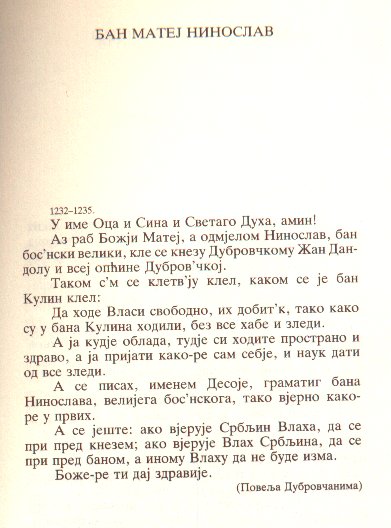
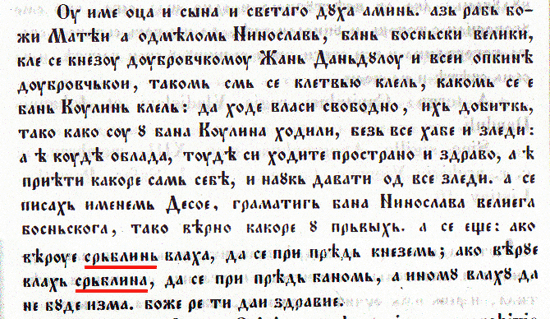
(The Charter of Matej Ninoslav, son of Radivoj, 1232-1235)
Ban Matej Ninoslav (from old Slavic to Serbian)
1232-1235
In the name of the father, son and the holy ghost!
I, God's slave, Matej, branch of Ninoslav, great viceroy of Bosnia, swear unto the prince of Dubrovnik
Dubrovnik's Zan Dandole (Gianni Dandolli) and all the regions of Dubrovnik.
I swear just as Ban Kulin swore before me:
For the Vlachs to walk freely as they did in the time of Ban Kulin, freely without
deceit and evil...thus if a
Vlach deceives a
Serb, may he be held in the Ban's court.
(Letter to the Dubrovnikers)
|

Ban Matej
Ninoslav, 1240
In the international accord on the lack on Bosnian-Dubrovnik relations, the Ban
(viceroy) Ninoslav explicitly calls his subjects "Serbs" (Srblji) and the Dubrovnikers "Vlachs" (Vlasi):
"For deceit by a Vlah of a Serb, a Bosnian court was to be conveyed. But for
deceit of a Serb over a Vlach, a court was to be convened in Dubrovnik."

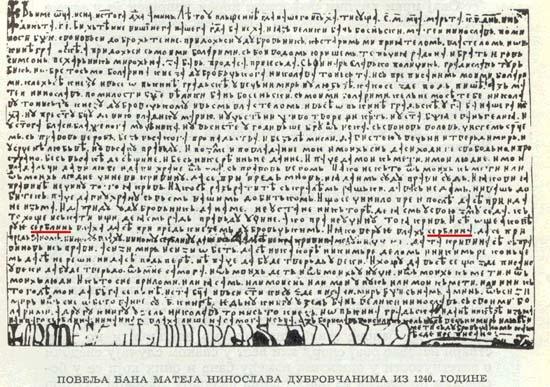
(The Charter of Matej Ninoslav, son of Radivoj, 1240)
Bosnian rulers called themselves Serbs, as they called Serbs their own subjects.
|
Tvrtko Kotromanic was crowned as 'the King of SERBS, Bosnia, the Seacoast and Western
Parts" on the grave of St. Sava in the Mileseva. In order to emphasize the relationship of the
Nemanjic (Serb in Rascia, the first Serbian state within the borders of modern Serbia) and Kotromanic (Bosnian Serb) dynasties , Tvrtko puts before his own
name, the title Stefan, which indicates that he is crowned. In
this letter the name Stefan is mentioned often (see for example the last word in the first sentence), just as it is also
emphasized in the letter the concept of "Serbian land" or
"Serbs" (Srbljem) as one ethnic categorization. For example, in the fifth line, Tvrtko clearly
indicates the roots of his 'parents of Serb nobility". Also, at
the end of the letter, on the right side in big letters there is emphasized the title "King of the
Serbs.
For a source, see the letters of the medieval rulers which are microfilmed in their original and are kept in the Dubrovnik archives. Also see the letters of the Bosnian ban (viceroy) Ninoslav.
The letters of the Bosnian nobles of the Kotromanic dynasty in which we clearly see how they felt their ethnicity to be
Serbian
Stefan
Tvrtko Kotromanic
Stefan
Dabisa Kotromanic
Stefan
Ostoja Kotromanic
Stefan
Ostojic Kotromanic
Stefan
Tvrtko II Kotromanic
Stefan Tomas
Kotromanic
All the above mentioned letters were written in the
Cyrillic script. There is a piece of the Zografic bible for those who think
Cyrillic and Glagolictic are interchangeable (11th century).
Zographic Bible |
|
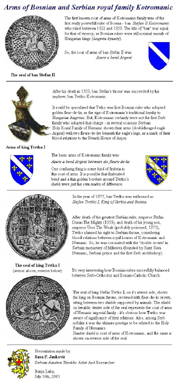
|
Bosnian Rulers called their Language Serbian
Bosnian ban (viceroy) Stefan Kotromanic (1322-1353) declares in 1333. a letter to Dubrovnik in which he states: "Thus I
the noble ban Stefan impress my golden seal, so that all may know and see the truth. This is why the seals are equal, two in Latin and two in Serbian and all are sealed in gold.".

(The Charter Stefan Kotromanic, 1333)
At the time, it was a tradition to give out four letters of the same text in Serbian and Latin. This letter may be found in:
Franz Miklosich, Monumenta Serbica, Vienna 1858. p. 105-109
Lj. Stojanovic - "Stare Srpske povelje i pisma" (Old Serbian Letters), I, 46.
Western sources and literature
On the Administration of the Empire (De Administrando Imperio), 10-th century
Constantine VII Porphyrogenitus
aka: CONSTANTINE VII FLAVIUS PORPHYROGENITUS (b. September 905, Constantinople [now Istanbul, Turkey]. Nov. 9, 959), the Byzantine emperor from 913 to 959.
His writings are an immense source regarding the empire and neighboring lands.
His work "De Administrando Imperio" is kept in its original manuscript in the
Vatican library. It deals primarily with the Slavic peoples of the Balkans and its a huge account of geographical and cultural as well as political situation of the Balkans at the time.
Porphyrogenitus does not only discuss the events of his lifetime, but of earlier periods such as that of Heraclius (610-641) and earlier.
Heading 32 of
De Administrando Imperio of Constantine Porphyrogenitus, is called "On the Serbs and the lands in which they live". It speaks of the territories inhabited by Serbs in which he mentions Bosnia, specifically two inhabited cities,
Kotor and Desnik, both of which are in an unidentified geographic position.
The annals of the Frankish chronologist Einhard, 9-th century
A source older than that of the is that of the
Frankish chronicler Einhard . In his annals („Royal
Frankish Annals”), so precious to Serb history, he describes the uprising of the Pannonian prince Ljudevit (818-823).
In his work, he claims that Ljudevit "withdrew from the city of Sisak and fled
to the Serbs".
Accordingly, Serbs must have lived somewhere around Una, maybe even to the west, likely where the modern Serbian Krajina (region of Lika) lies.
"Liudevitus Siscia civitate relicta, ad Sorabos, quae natio magnam Dalmatie partem obtinere dicitur, fugiendo se contulit"
, that is:
"Ljudevit (prince of Lower Pannonia 822. -
prim. CafeHome) having left the city of Sisak, fled to the Serbs, people
inhabiting the greater part of Dalmatia).
Franjo Racki, the Croatian historian, says, that as the
Roman province of Dalmatia stretched from the Adriatic to Pannonia, under those Serbs, who
are mentioned by Einhard, we must look at all those lands between, and the people inhabiting
them, ie: Bosnia to be considered Serbian land, inhabited by Serbs.
The letter to Dubrovnik
The Pope sent in 1188 to the bishop of Dubrovnik a letter and in it he acknowledges all the old
rights of the Dubrovnik church. In the letter, he mentions Serbian Bosnia: "regnum Servilie,
quod est Bosna" (Serbian kingdom of Bosnia). That was in the time of Ban Kulin.
("regnum" must have loosely meant kingdom in that time for, Bosnia was then a "banovina")
From: I. Kukuljevic, Codex diplom, II, 148, p. 21.)
In Perugia, February
24th., 1252
In
his letter, Johannes, the archbishop of Dubrovnik (archiepiscopus Ragusinus),
mentions Serbian Bosnia: "regnum Seruilie, quod est Bosgna" i.e. "Serbian
kingdom of Bosnia". ("Regnum" must have loosely meant kingdom in that time for,
Bosnia was then a "banovina".)
"...tria regna, videlicet regnum
Zachlomie, regnum Seruilie, quod est Bosgna et regnum Tribunie. Et regnum
Zachulmie extenditur vsque ad prouinciam Spalatensem, regnum Seruilie extenditur
vsque ad prouinciam Collocensem, regnum Tribunie extenditur vsque ad prouinciam
Dirachinam."
From: "Bullarium Ragusium", 401-402
The Writings of father Diocletian (Dukljanin) also known by its Serbian acronym LPD, 12-th
century
Encyclopedia Britannica1. The first recorded mention of Bosnia was written during this period by the Byzantine emperor Constantine VII Porphyrogenitus, who described "Bosona" as a district in "baptized Serbia."
2. TVRTKO KOTROMANIC (b. c. 1338--d. 1391), probably the greatest ruler of Bosnia, ruling as Bosnian ban (provincial lord, subservient to the king of Hungary) from 1353 and king of the Serbs and Bosnia from 1377.
3. The Ottoman Turks invaded Bosnia in 1386, and after many battles it became a Turkish province in 1463. Hum held out longer under rulers who styled themselves herceg ("duke") of St. Sava--a name recalled today in Herzegovina.
The Catholic Encyclopedia, 1917
Bosnia and Herzegovina
Population"Excluding some 30,000 Albanians living in the south-east, the Jews
who emigrated in earlier times from Spain, a few Osmanli Turks, the merchants,
officials. and Austrian troops, the rest of the population (about 98
per cent) belong to the southern Slavonic people, the Serbs. Although one in
race, the people form in religious beliefs three sharply separated divisions:
the Mohammedans, about 550,000 persons (35 per cent), Greek Schismatics, about
674,000 persons (43 per cent), and Catholics, about 334,000 persons (21.3 per
cent). The last mentioned are chiefly peasants."
De Originibus Slavicis, 1745, Joan Christofori de Jordan
In his study of the Slavs (De Originibus Slavicis, 1745), Joan Christofori de
Jordan, one of the founders of Slavistics in Germania, believes that early
German sources, namely Einhard (e.g. Sorabos, quae natio magnam Dalmatiae partem
obtinere dicitur), offer important information as to Serbia-Bosnia's western
borders. According to Christofori, all the historical evidence strongly suggests
that Serbi-Bosnia's western border ran along the Una and Sava rivers, centered
at Srb, an ancient stronghold on the Una River.
Illyria Sacrum, Daniele Farlati
Illyria Sacrum is a massive eight-volume history of the Church in Illyria
prepared in the 18th and 19th centuries by three Italian Jesuits, Filipo
Riceputi, Daniele Farlati and Jacobo Coleti. Illyria Sacrum is based on some 300
volumes of raw source materials collected over a twenty-year period. The first
volume was published in 1751 and the eighth in 1819.
Historically speaking, Farlati writes, there are two Serbias. One Serbia is
Primorje or Maritime Serbia. The other Serbia is Zagorje or Interior Serbia.
Zagorje is made up of two parts, Bosnia and Rascia/Raska (partes Serbliae).
Bosnia (pars Serbliae), Farlati writes, like Raska, is a Serb land, an original
and integral part of Zagorja or Interior Serbia.
Maps of Europe
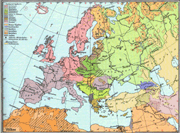
Direcke-Weltaltlas, begründet von C. Diercke, fortgeführt von R. Dehmel,
Braunschweig 1973 176 (88 d. Neubearbeitung), S. 85.
|
 |
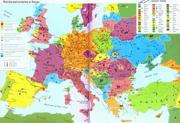
Reaction and revolution in Europe
|
 |
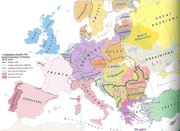
Languages, peoples and political divisions of Europe, 1815-1914
|
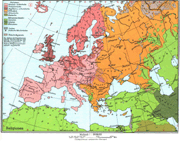
Direcke-Weltaltlas, begründet von C. Diercke, fortgeführt von R. Dehmel,
Braunschweig 1973 176 (88 d. Neubearbeitung), S. 85.
|
 |
![The Times "Atlas of World History", Edition 1978, page 214: Languages, peoples and political divisions of Europe [1800 to 1914]](mapsofeurope/180px-map-Europe-1914.gif)
The Times "Atlas of World History", Edition 1978, page 214: Languages, peoples and political divisions of Europe [1800 to 1914]
|
 |
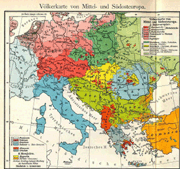
F. W. Putzgers Historischer Schul-Atlas, 1905
|
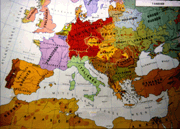
Linguistic Divisions of Europe in 1914
|
 |
|
 |
|
Linguistic variants
|
Stjepan, Stepan, Stipan, Scepan, Stefan,
Stevan was one and the same name. Because the letter "J" did not exist before
Vuk Karadzic's (Serbian reformer) reforms, but the letter "JAT" did exist, the
reader could interpret the sound to be read in any way, depending on which
dialect he spoke and how the dialect or regionalism pronounces the sound "J".
The Serbian Epic of the emperor Stefan Dusan: "Zenidba Dusanova" (wedding of
Dusan) :
When the Serbian Czar Stephan,
looked to marry a wife,
In the Latin city of Ledjin,
of the Latin king Michael,
a maden by the name of Roksana
(Vuk KaradzicII/28) |
|
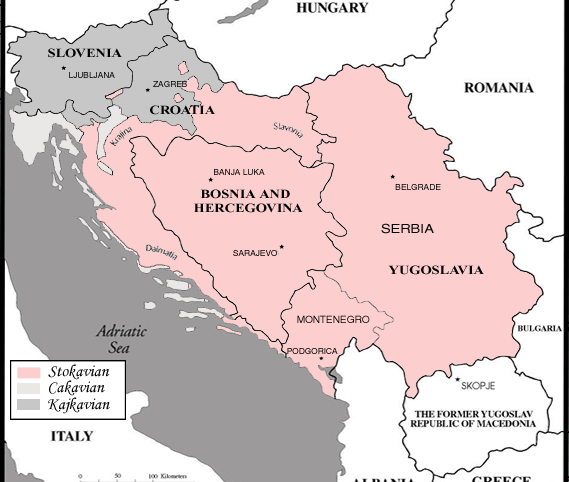
(Geographic Distribution of South Slavic Languages)
|
Thus from king Tvrko all rulers carried the name STEPHAN.
(see their
letters.)
Surely, nobody would take that as proof that those were Serbs. The indicators of national
feelings are those documents where Bosnian rulers write that they and their
forefathers were
Serbs and that those they rule are Serbs as well and that they speak the Serbian
language.
The concept of a state in the middle ages
If we study the middle ages we must analyze the concept of the state. Modern states have the
tendency to be national in character, ie: to occupy the area encompassing the
members of a
given nation. Because of that they are much larger today. As is known, in the middle ages,
belonging in the administrative sense to a geographic area says nothing about ones ethnicity. It is
known that ruling dynasties used relations, marriages, so that they could expand their influence
which would not even constitute territorial continuity. For example: the Spanish kings ruled
land which was thousands of kilometers way from the mainland, even Belgium at one point.
That doesn't say that the population of Belgium at the time was ethnically Spanish. In the same
way, an ethnic mass could encompass over ten or even more fiefdoms, provinces, kingdoms, as
was the case with the Germans, Irish and French. That does not mean that two
separate German
states were two separate nationalities. The same goes for religious differences. The faith of the
people was determined by the faith of the ruler, and that faith is known to have changed many
times over. Even today it is not uncommon to see peoples with two or three faiths like the
Germans or the Magyars.
As a relevant source for the study of national identity, the population of an area maps are not an
excellent source. What could be better for the study of national feeling in the middle ages than
the documents of the rulers who give clear signs of themselves, their subjects and the language
they spoke?
To illustrate on tofu the above arguments see the map of Europe in this period, say 1400 (while
the Ottomans had not yet conquered Bosnia). Clearly we are bombarded by a pile of
administrative bodies divided into many nationalities, eg: France and Germany, however there are
also single bodies encompassing whole nations or more than one.
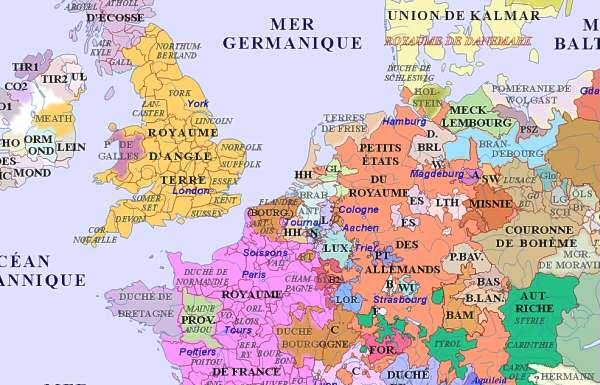
(Europe in 1400)
Titles
It is interesting to see what titles the rulers of the middle ages carried and what the "states" at the
time were called.
The title of the Nemanjic rulers was as follows: "The King of the land of Rashka, Dioclea,
Travunija, Dalmatia and Zahumia."
(in time, Dioclea was to be called Zeta)
Czar Dusan the Great as a Czar (emperor) takes the title "Emperor of Serbs and Greeks"
(Romans) which he bestows to his son Uros, and the next emperor to have that title would be
Tvrtko because he saw himself to be clearly "King of the Serbs", thus all kings from Bosnia
would carry that title, without even mentioning another nationality, but only geographic areas
which they ruled.
Only in Latin sources, however did they call Raska Serbia, though all Serbs called Raska
'Raska".
The title of King Tvrtko was "King of Serbs, Bosnia and the Seacoast ".

("King of Serbs", Tvrtko's Royal Insignia)
Until 1390, Tvrtko carried the title je do 1390. "King of Serbs, Bosnia and the Seacoast and
Western Areas". From this title we can see that he ruled only one people, the Serbs. When
Tvrtko conquered parts of lands inhabited by another nation, like fore example, the Croats, his
title was changed in 1390 to "King of Rashka, Bosnia, Dalmatia, Croatia and the Sea Coast.
When he conquered the lands of another nation (the Croats) he changed his title so that there
would be no ethnic distinction "King of Serbs" because the Serbs were not the only people
which he ruled, because lands inhabited by Croats were incorporated into the empire.
From this, we clearly see to what extent Tvrtko was conscious that he was a Serb and that
SERBS live in Bosnia, because while he ruled only Bosnia and parts of Raska and the Sea Coast,
he was KING OF THE SERBS.
When Bosnia lost parts of Croatia which it had conquered, after Tvrtko, the next Bosnian ruler
took the title "King of the Serbs", because they no longer ruled Croatia but returned again to
ruing Serbs only. This all speaks of how conscious the Bosnian nobles were that they were Serbs.
All Bosnian Kings call themselves "King of the Serbs" which is the only ethnic name used in the
title. They were of course Kings of Bosnia but they only mention Bosnia as a territory just as they
saw other lands as territories. They make no mention of any nation over which they rule
except
Serbs, and Tvrtko even mentions his forefathers in his letters. They called their subjects Serbs as
well even before the incorporation of Serbia and Raska. In passing, Tvrtko called the state of the
Nemanjic kings Raska because it was the only name of that land which we today call Serbia.
The Miroslav's Gospel
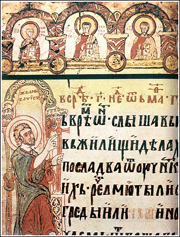
(A page from Miroslav's Gospel, one of the first
extant manuscripts written in the Serbian variant of Church Slavonic,
from the end of the twelfth century)
|
|
The Miroslav's Gospel,
the most valuable and the oldest manuscript written in Serbian
in the Cyrillic script, date from the last quarter of the 12th century.(about
1190 A.D.) Confirmation of this dating is also found in
words written by one of the scribes on the last page of the manuscript:"I,
sinful disciple Gligorije... have inscribed in gold these Gospel for the
celebrated prince Miroslav, son of Zavida..."
Prince Miroslav, brother of Grand Zhupan Stefan Nemanja, was the ruler of
Hum, an area that largely coincides with the territory of present-day
Herzegovina. He may have commissioned this manuscript at the time of his
endowment of St. Peter’ s church on the Lim River, but no information or even
legend exists about how or when the Gospel was taken from Hum to Chilandari
monastery on Mt. Athos. One possibility is that Nemanja brought it with him when
he founded Chilandari. It is the earliest and most beautiful manuscript with
rich coloured illustrations written in Serbian in Cyrillic script. The Gospel
had been preserved in the library of Hilandar Monastery on the Holy Mountains,
Athon (Greece). During the previous two centuries, the Gospel changed several
times its place until it was kept in the National Museum of Belgrade. |
Links
From the Serbian cafe discussions: Discussions - History
See the page on the nobility.

Last updated: January, 05. 2004
This page is best viewed at 800x600 resolution
|
 |